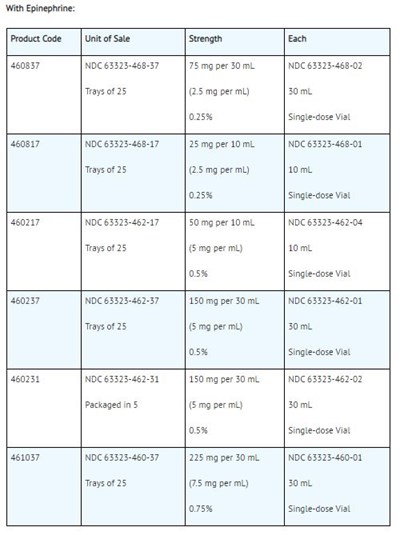Product Images Sensorcaine Mpf
View Photos of Packaging, Labels & Appearance
Product Label Images
The following 10 images provide visual information about the product associated with Sensorcaine Mpf NDC 0404-9946 by Henry Schein, Inc., such as packaging, labeling, and the appearance of the drug itself. This resource could be helpful for medical professionals, pharmacists, and patients seeking to verify medication information and ensure they have the correct product.
Image1.jpg - Image1

The use of 0.75% Sensorcaine concentration during obstetrical anesthesia is not recommended due to reports of cardiac arrest, difficult resuscitation, and death. Local anesthetics should only be used by experts in management of dose-related toxicity and other acute emergencies. Local anesthesia solutions with antimicrobial preservatives should not be used for epidural or caudal anesthesia. Post-marketing reports have shown cases of chondrolysis following intra-articular infusions of local anesthetics. Aspiration for blood or cerebrospinal fluid is recommended before injecting local anesthetics. Bupivacaine with Epinephrine 1:200,000 should not be used with ergot-type oxytocic drugs. Bupivacaine administration is not recommended for children younger than 12 years. Bupivacaine should not be mixed or used with any other local anesthetic. Bupivacaine use during intravenous regional anesthesia (Bier Block) has led to reports of cardiac arrest and death.*
Image2.jpg - Image2

This text is a list of drugs that are associated with causing Methemoglobinemia, which is a condition where the blood is unable to carry oxygen effectively. The different classes of drugs include Nitrates/Nitrites, Local anesthetics, Antineoplastic agents, Antibiotics, Antimalarials, Anticonvulsants, and other drugs such as acetaminophen, metoclopramide, quinine, and sulfasalazine.*
Label1.jpg - Label1

This is a medication called SENSORCAIME MPF 0.6%, also known as Bupivacaine HCL, used for nerve blocking, caudal and epidural anesthesia. It should not be used for spinal anesthesia, and the unused portion should be discarded. Each milliliter of solution contains 5mg of Bupivacaine HCL and is adjusted to pH 4.0-6.5 using sodium chloride, sodium hydroxide, and/or hydrochloric acid. The medication comes in a 10ml single-dose vial and should not be used if the solution is discolored or contains a precipitate. It can be resterilized by autoclaving. The medication is methylparaben-free and should be kept out of children's reach at a controlled room temperature of 68-73°F. The packaging information including GTIN, SER, LOT, and EXP dates is also provided.*
Table1.jpg - Table1

This text provides information about different types of local anesthesia and blocks, with varying percentages based on the type of procedure. It includes details on infiltration, nerve blocks, retrobulbar block, sympathetic block, lumbar epidural, caudal, epidural test dose, and dental blocks. The dosage and administration information is also mentioned.*
Table2.jpg - Table2

Recommended Concentrations and Doses of Sensoreaine (bupivacaine HCY) injections are provided in Table 1. There is additional information about the recommended doses for epidural injections. The rest of the text is not readable.*
Table3.jpg - Table3

This is a list of different Epinephrine products available for sale. The list includes the product code, strength, unit of sale, and NDC (National Drug Code) for each product. The listed products are available in different doses and are either single-dose or trays of 25.*
Table4.jpg - Table4

This is a list of medication products with their strengths, quantities, and packaging information. The products seem to be single-dose vials and trays with either 5mg per 10ml or 75mg per 30ml strengths, and pack counts of 25 and 30. The products are labeled as being without epinephrine, and some have a strength of 0.25%, while others have a strength of 0.5%.*
Table5.jpg - Table5

This appears to be a list of various epinephrine and non-epinephrine products, with product codes, unit of sale, and strength information included. The products include multiple-dose vials with different strengths and trays of 25mg and 250mg options.*
* The product label images have been analyzed using a combination of traditional computing and machine learning techniques. It should be noted that the descriptions provided may not be entirely accurate as they are experimental in nature. Use the information in this page at your own discretion and risk.

